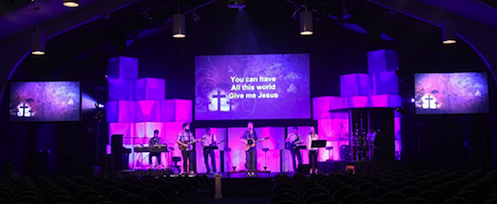Church media. Is it necessary? Worthless? Dangerous? Distracting? If churches are spending their money and time on media, it’s perfectly appropriate to ask these kinds of questions. Allow us to wax philosophical. Sharefaith, as a church media provider, is very interested in this question, since we are trying to serve the church by providing top-notch media resources. You may be interested in this question, too.
First off, what’s “church media?” For this discussion, you can think of anything that is a printed, projected, or visual medium of communication. “Church media” may encompass stage design, the sign out front, the printed bulletins, the pre-reel, the welcome videos, or the sermon PowerPoint. For now, we’re not talking about the music or the preaching specifically.
Here is our proposal:
Church media is a useful tool for most churches today.
What do you think? We suggest that church media is a good tool for many churches to consider. We’re not just saying this because it’s our business. Here’s why we make this suggestion:
1. Church media helps to emphasize the gospel.
Communication takes place on many different levels. When your pastor preaches, he is using his voice to speak words. He is using his body to make gestures to emphasize those words. Perhaps he is backed by a stage design that further emphasizes his message. Also, he may be using videos, pictures, printed words, or PowerPoint to drive the point home even further. Each level of communication serves to inform, emphasize, and even enhance his message. A great-looking PowerPoint design gives the pastor the ability to communicate his message — the gospel — even more clearly. When people receive information in more than one way, they tend to remember it better. The more senses that are involved, the better. So, if a spoken sermon uses visual aids — such as a PowerPoint, object lessons, or something else — the message is likely going to stick in the hearer’s mind a lot better.
2. Church media connects with people in a language that is understandable and familiar.
When you communicate to people, you want to speak their language. That’s obvious. When was the last time you preached in Latin? The same truism applies to other forms of communication. We live in a media-saturated world. The point of using media in church is not simply to add to the supersaturation of media, but to provide a form of communication that is readily understood by people. Our cultural collective communication style now favors mediums that include screens, motion, and color. That’s neither bad nor good. It simply is. Using media, therefore, is not using the devil’s means to spread God’s truth. It is simply using a culturally relevant form of communication. Few people walk around wearing sandwich boards for advertising purposes anymore. That might have been effective a few generations ago, but is no longer culturally relevant. It’s just weird. Today, however, we put up church marquees and motion video backgrounds. Maybe in fifty years, we won’t be doing that.
3. Church media enables a wider breadth of communication.
Church media communicates far more than just what is printed on the paper, or projected onto the screen. Communication philosopher Marshall McLuhan is widely recognized for his statement, “the medium is the message.” While it may be overstatement, the phrase has some truth. The form of communication affects the message communicated. Let’s use the example of visual aids in Sunday School. When a teacher uses a visual aid, such as a felt cut-out of Joseph, he is communicating a Bible story that suggests real people, in real life, with real bodies that we can recognize. His medium — felt shapes and pictures of people — carries an important message that adds to his communication. Similarly, if the Sunday school teacher were to use a PowerPoint projection of characters, backdrops, action, and settings, he provides an even richer level of experience and communication for the children. On another deeper layer, the communication suggests that the teacher has technological capacity, a willingness to do what is appropriate to communicate, a desire for excellence, and a passion for communicating in the best way possible.
Some Final Words on Church Media
We think that many churches can consider using church media, but we say so without using words like “must,” or “should.” In fact, we recognize pitfalls and dangers with church media, just as in any area of life and ministry. Here are some things to be aware of.
- Church media is not absolutely necessary. A church is just fine without a sign, without bulletins, without a website, and even without a building. The church is people — the bride of Christ — not the stuff we attach to it. Christ will build his church, whether or not the church has a media projector.
- The effectiveness of church media depends on how you use it. Media alone is not effective. Media used intentionally, purposefully, and excellently, is more likely to be effective.
- Use church media with caution. Anything can be misused, and church media is prone to its share of abuses. One such abuse is elevating church media to a point where it becomes more important than it ought to be. Another abuse is elevating the “relevance” of the media, so called, to the detriment of actual truth.
- Make use of church media in a way that makes sense based on your ministry context. Every church is different. Every context is different. Your ministry can make use of media in a way that will be most effective. A careful understand of the people you to whom you are ministering will be the best way to determine your use of media.
Church media is simply a tool. Like all tools, it can serve the church. As you pursue the best possible method of ministry, you can consider church media as one of the tools for communicating the gospel to people today.

